Optics | Physics - Refraction at Single Spherical Surface | 12th Physics : UNIT 6 : Ray Optics
Chapter: 12th Physics : UNIT 6 : Ray Optics
Refraction at Single Spherical Surface
REFRACTION AT SINGLE SPHERICAL SURFACE
We have so far studied only the
refraction at a plane surfaces. The refractions also do take place at spherical
surface between two transparent media. The laws of refraction hold good at
every point on the spherical surface. The normal at the point of incidence is
perpendicular to the tangent plane to the spherical surface at that point.
Therefore, the normal always passes through its center of curvature. The study
of refraction at single spherical surface paves way to the understanding of
thin lenses which consist of two surfaces of which one or both must be
spherical.
The following assumptions are made
while considering refraction at spherical surfaces.
(a) The incident
light is assumed to be monochromatic (single colour)
(b) The incident
ray of light is very close to the principal axis (paraxial rays).
The sign conventions are similar to
that of the spherical mirrors.
Equation for refraction at single spherical surface
Let us consider two transparent
media having refractive indices n1
and n2 are separated by a
spherical surface as shown in Figure 6.31. Let C be the centre of curvature of the spherical surface. Let a point
object O be in the medium n1. The line OC cuts the spherical surface at the
pole P of the surface. As the rays considered are paraxial rays, the
perpendicular dropped for the point of incidence to the principal axis is very
close to the pole or passes through the pole itself.
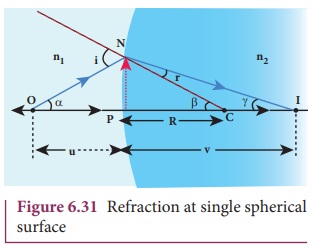
Light from O falls on the refracting surface at N. The normal drawn at the point of incidence passes through the
centre of curvature C. As n2>n1, light in the denser medium deviates towards the
normal and meets the principal axis at I where
the image is formed.
Snell’s law in product form for the refraction
at the point N could be written as,

As the angles are small, sine of the
angle could be approximated to the angle itself.

Let the angles,
∠NOP = α, ∠NCP = β, ∠NIP = γ
tanα = PN/PO ; tanβ = PN/PC ; tanγ =
PN/PI
As these angles are small, tan of the angle could be approximated to the angle itself.

Substituting for i and r from equations (6.53) and (6.54) in the equation (6.51).
n1(α + β) = n2
(β − γ)
Rearranging,
n1α + n2γ = (n2 −n1)β
Substituting for α, β
and γ from equation (6.52),

Further simplifying by cancelling
PN,

Following sign conventions, PO = –u, PI = +v and PC = +R in equation
(6.58),

Equation (6.56) gives the relation
among the object distance u, image
distance v, refractive indices of the
two media (n1 and n2 ) and the radius of
curvature R of the spherical surface.
It holds for any spherical surface.
If the first medium is air then, n1 = 1 and the second medium
is taken just as n2 = n, then the equation is reduced to,

EXAMPLE 6.12
Locate the image of the point object
O in the situation shown. The point C denotes the centre of curvature of the
separating surface.
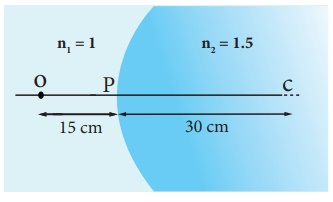
Solution
Given, u = –15 cm, R = 30 cm, n1 = 1 and n2 = 1.5
Equation for single spherical
surface is,

v = –30 cm
The image is a virtual image formed
30 cm to the left of the spherical surface.
Lateral magnification in single spherical surface
Let us, consider an extended object OO’ is kept perpendicular to the
principal axis to the left of the single spherical surface as shown in Figure
6.32. The image formed on the other side of the surface is II ‘ . Consider a ray from O’
in the first medium towards C in the
second medium. As this ray is incident normal to the spherical surface, it goes
undeviated in the second medium.The position of image may be located using the
Equation (6.60).
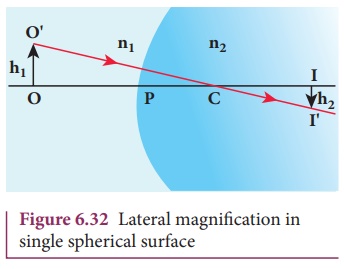
The lateral or transverse
magnification m is defined as the
ratio of height of the image to the height of the object.

From the two similar triangles ∆ COO’ and ∆ CII ' , we can write,
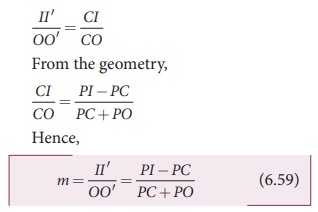
Applying sign conventions in the
above equation (6.59),
II ′ = −h2 , OO′ = h1 , PI = +v,
PC = +R, PO = −u
Where, h1 is the height of the object and h2 is the height of the image.
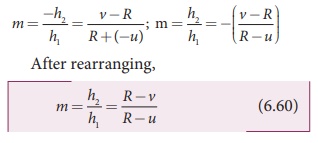
We can also arrive at an equation
for lateral magnification involving the refractive indices of the two media.
Let us consider the equation for
single spherical surface as,
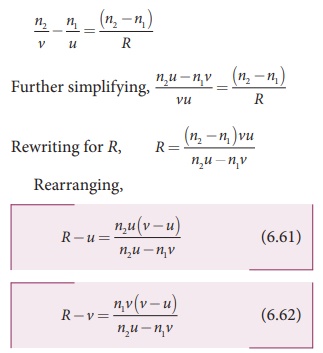
Substituting equations (6.61) and
(6.62) in equation (6.60) we get the equation for lateral magnification as,

EXAMPLE 6.13
Find the size of the image formed in
the given figure.

Solution
Given, u = –40 cm, R = –20 cm, n1 = 1 and n2 = 1.33
Equation for single spherical
surface is,
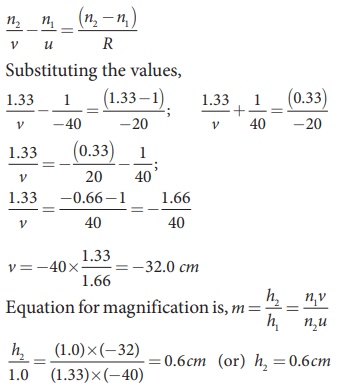
= 0.6cm (or) h = 0.6cm
The erect virtual image of height
0.6 cm is formed at 32.0 cm to the left of the single spherical surface.
Related Topics